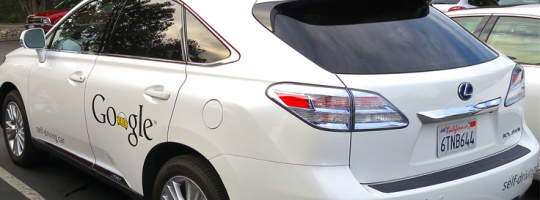Google Announces New Auto Ad Offering And Other Mobile-Focused Enhancements

At the second annual Inside AdWords event this week, Google made the very impressive statement that mobile searches have now overtaken desktop in 10 countries. The company announced a number of new product updates, including new ad types in the automotive vertical, which comes as big news for digital marketers and for the auto industry.
“We’ve hit an inflection point where more Google searches are taking place in mobile than desktop in 10 countries, including U.S. and Japan,” said Jerry Dischler, Vice President of Product Management for AdWords. “We think it’s a real turning point in digital advertising and we have been investing in mobile-focused initiatives.”
Dischler explained that over 50 percent of automotive searches now happen on mobile, which is certainly a very important statistic for dealerships to know. To meet this changing landscape, Google is rolling out two new ad types in the auto vertical: automotive ads for OEMs and dealer ads. The new search ad format links to a carousel of both interior and exterior images of a car that users can swipe through on their mobile device. By tapping on one of the images, users can bring up a page with additional information about the vehicle. Tapping on the “Dealers” link in the initial ad, or on the landing page, takes users to a search results page that includes a “three-pack” of ads with nearby dealership listings.
“Car buyers spend up to 15 hours online researching, comparing and learning,” Google wrote about its new automotive ad offerings. “When people browse the Web for automobiles, they want to see pictures and visuals of their dream car. In fact, about half of Google searches for cars contain images. That’s why we introduced Automobile Ads – a new search ad format that takes you directly from Google.com to a beautiful carousel of car images that shows you how a car looks inside and out– like how the sleek metallic finish looks with the black leather and wood trim.”
In recent times, there has been a great deal of discussion in the digital marketing industry about the rise of mobile and the changing landscape of search. Consumers have increasingly high expectations for immediate information in the moment, regardless of where they are. With Google’s new ad offerings that are designed for mobile, consumers will experience more engaging ads, which will help dealerships to reach customers in the perfect moment when they are searching for a car in their area.
In addition to the new automotive ad types, Google is also rolling out new offerings in the hotel and mortgage verticals. The new hotel ads show current prices from a variety of sources, and subsequently allow a consumer to select “Book” to complete a reservation on the partners’ sites. Mortgages will soon be added to Google Compare in the U.S., to allow consumers to view the latest mortgage rates from multiple providers, and then apply directly or speak to an adviser for additional information, all directly from the Google search ad.
Marketers are becoming increasingly aware of the importance of being there in what Google calls “micro-moments.” When consumers are conducting mobile searches, they are often ready to visit a dealership either immediately or within one day, and Google’s new auto ad types will help marketers provide highly relevant and engaging information to draw users into physical locations.
Another big focus of Google’s announcement was measurement, with enhanced tools for marketers to measure performance across “micro-moments” on devices, apps, calls and in-store visits. The company is launching AdWords attribution with the goal of making it easier for search marketers to “move beyond a last-click attribution model” to learn more about what influenced a purchase. Marketers will now be able to select an attribution model for each of their conversion types. This selection will then be reflected in their AdWords reporting and integrated into their automated bidding. Additionally, Google is introducing data-driven attribution, to use a marketer’s own conversion data to calculate the actual contribution of each keyword across the conversion path.
Google also announced an upcoming product that will allow marketers to better measure activities that start on one device and are subsequently completed on another. “Later this year, you’ll be able to take action on these insights when cross-device conversions are integrated into automated bidding,” explained Google. “This is part of a broader update that will give you the option to include cross-device conversions as part of the Conversions column.”
The “estimated store visits” tool launched last year in the U.S., Canada and Australia. Google announced that it will roll out to 10 more countries in the coming months. This product shows great promise for marketers, as it uses a plethora of data, from Google users who share their location data, to information from the Google geo team that has mapped hundreds of millions of buildings, to a panel of Google users that the company can query with questions such as “Are you in Target right now?.” By analyzing this data, Google is able to determine valuable directional data on store visits. By cross-referencing this data with users who saw local ads for the locations that they are currently in, Google can effectively measure store traffic and ad ROI. Although the number is certainly an estimate, the company is confident that the analytics provide a valid measurement of ROI.
There’s no question that the digital marketing landscape is shifting, with the rise of mobile, an increase in multiple device usage and the growth of immediate consumer intent when conducting Web searches. Google’s focus on being the connection between marketers and consumers in the “micro-moments” of purchasing decisions is resulting in its development of enhanced ad offerings and measurement tools that are certain to be of great interest to the entire digital marketing industry.












Warning: count(): Parameter must be an array or an object that implements Countable in /home/pg4b1yzvrqqo/domains/test.drivingsalesnews.com/html/wp-includes/class-wp-comment-query.php on line 399
Mobile applications have become a necessary tool that gives additional opportunity to sell to this specific customer. We do find that the attention span is short and if not responded to in seconds this perspective buyer is off to the next dealership.